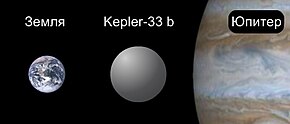 The size of Kepler-33b as compared to Earth and Jupiter | |
| Discovery [1] | |
|---|---|
| Discovered by | Jack Lissauer |
| Discovery site | Moffett Field, California |
| Discovery date | January 26, 2012 |
| Transit | |
| Designations | |
| KOI-707.05 [2] | |
| Orbital characteristics | |
| 0.0677±0.0014 AU [3] | |
| Eccentricity | 0 |
| 5.66793±0.00012 d [3] | |
| Inclination | 86.39±1.17° [3] |
| 90° [2] | |
| 2454964.8981±0.0075 jd [2] | |
| Physical characteristics | |
| 0.16±0.02 RJ [3] | |
| 3.6g [2] | |
Kepler-33b is an extrasolar planet orbiting Kepler-33 in the constellation Cygnus. It is one of five planets orbiting Kepler-33.
Kepler-33b was, along with twenty-six other planets in eleven different planetary systems, confirmed to be a planet on January 26, 2012. [1] [4]
Kepler-33b orbits its host star with 4 other planets. All five planets orbit its star closer than Mercury does to the Sun. [5] Of those five, Kepler-33b is closest. [4] All Kepler-33 planets are too close to be in the habitable zone. [6]
- ^ a b Lissauer, Jack J.; Marcy, Geoffrey W.; Rowe, Jason F.; Bryson, Stephen T.; Adams, Elisabeth; Buchhave, Lars A.; Ciardi, David R.; Cochran, William D.; Fabrycky, Daniel C.; Ford, Eric B.; Fressin, Francois; Geary, John; Gilliland, Ronald L.; Holman, Matthew J.; Howell, Steve B.; Jenkins, Jon M.; Kinemuchi, Karen; Koch, David G.; Morehead, Robert C.; Ragozzine, Darin; Seader, Shawn E.; Tanenbaum, Peter G.; Torres, Guillermo; Twicken, Joseph D. (January 26, 2012). "Almost All of Kepler's Multiple Planet Candidates are Planets". The Astrophysical Journal. 750 (2): 112. arXiv: 1201.5424. Bibcode: 2012ApJ...750..112L. doi: 10.1088/0004-637X/750/2/112. S2CID 30549908.
- ^ a b c d "Kepler-33b". exoplanets.org. Retrieved December 31, 2012.
- ^ a b c d "Kepler-33b". kepler.nasa.gov. Archived from the original on May 3, 2012. Retrieved December 31, 2012.
- ^ a b "NASA's Kepler announces 11 planetary systems hosting 26 planets". kepler.nasa.gov. January 26, 2012. Archived from the original on March 18, 2012. Retrieved December 31, 2012.
- ^ "NASA's Kepler mission announces 11 planetary systems hosting 26 planets". ucsc.edu. January 26, 2012. Retrieved December 31, 2012.
- ^ "Planet Kepler-33 b". hanno.rein.de. Archived from the original on June 28, 2013. Retrieved December 31, 2012.
 The size of Kepler-33b as compared to Earth and Jupiter | |
| Discovery [1] | |
|---|---|
| Discovered by | Jack Lissauer |
| Discovery site | Moffett Field, California |
| Discovery date | January 26, 2012 |
| Transit | |
| Designations | |
| KOI-707.05 [2] | |
| Orbital characteristics | |
| 0.0677±0.0014 AU [3] | |
| Eccentricity | 0 |
| 5.66793±0.00012 d [3] | |
| Inclination | 86.39±1.17° [3] |
| 90° [2] | |
| 2454964.8981±0.0075 jd [2] | |
| Physical characteristics | |
| 0.16±0.02 RJ [3] | |
| 3.6g [2] | |
Kepler-33b is an extrasolar planet orbiting Kepler-33 in the constellation Cygnus. It is one of five planets orbiting Kepler-33.
Kepler-33b was, along with twenty-six other planets in eleven different planetary systems, confirmed to be a planet on January 26, 2012. [1] [4]
Kepler-33b orbits its host star with 4 other planets. All five planets orbit its star closer than Mercury does to the Sun. [5] Of those five, Kepler-33b is closest. [4] All Kepler-33 planets are too close to be in the habitable zone. [6]
- ^ a b Lissauer, Jack J.; Marcy, Geoffrey W.; Rowe, Jason F.; Bryson, Stephen T.; Adams, Elisabeth; Buchhave, Lars A.; Ciardi, David R.; Cochran, William D.; Fabrycky, Daniel C.; Ford, Eric B.; Fressin, Francois; Geary, John; Gilliland, Ronald L.; Holman, Matthew J.; Howell, Steve B.; Jenkins, Jon M.; Kinemuchi, Karen; Koch, David G.; Morehead, Robert C.; Ragozzine, Darin; Seader, Shawn E.; Tanenbaum, Peter G.; Torres, Guillermo; Twicken, Joseph D. (January 26, 2012). "Almost All of Kepler's Multiple Planet Candidates are Planets". The Astrophysical Journal. 750 (2): 112. arXiv: 1201.5424. Bibcode: 2012ApJ...750..112L. doi: 10.1088/0004-637X/750/2/112. S2CID 30549908.
- ^ a b c d "Kepler-33b". exoplanets.org. Retrieved December 31, 2012.
- ^ a b c d "Kepler-33b". kepler.nasa.gov. Archived from the original on May 3, 2012. Retrieved December 31, 2012.
- ^ a b "NASA's Kepler announces 11 planetary systems hosting 26 planets". kepler.nasa.gov. January 26, 2012. Archived from the original on March 18, 2012. Retrieved December 31, 2012.
- ^ "NASA's Kepler mission announces 11 planetary systems hosting 26 planets". ucsc.edu. January 26, 2012. Retrieved December 31, 2012.
- ^ "Planet Kepler-33 b". hanno.rein.de. Archived from the original on June 28, 2013. Retrieved December 31, 2012.


